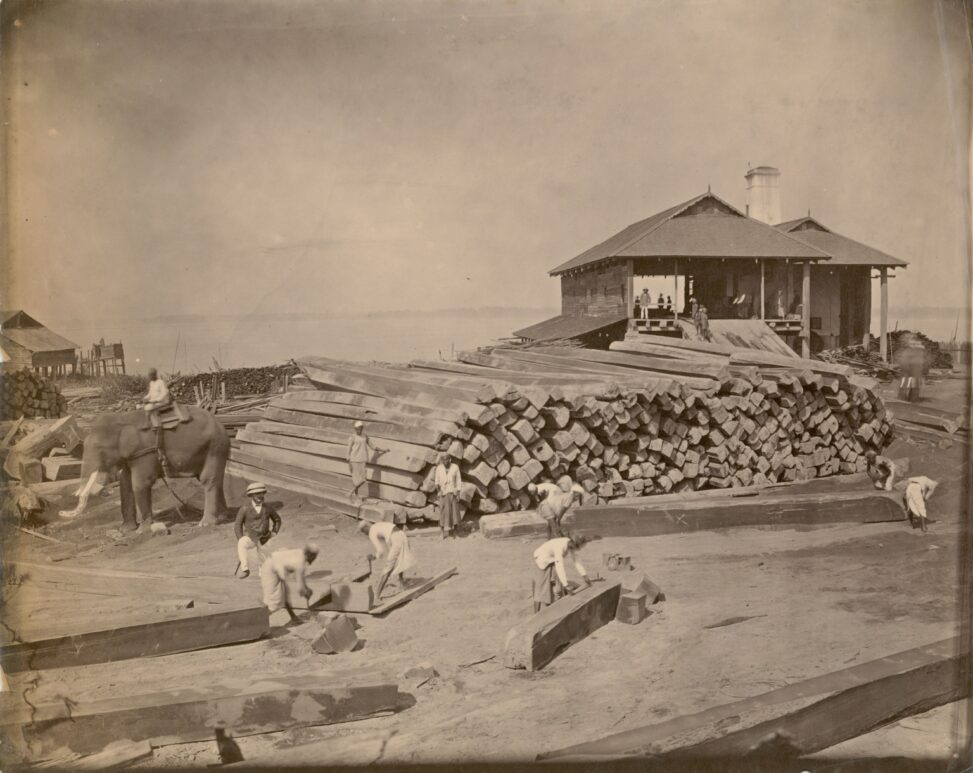The Elephant in the Room
Photo: Elephant Moving Timber in Moulmein, Myanmar (Burma), 1885-1895, Ira Wolff Photographic History Collection
Off the coast of Moulmein in the late 1800s, ethnic Burmans are depicted with saws and axes in hand. On this hot, humid day, British officials oversee this lumber yard. No locals are safe from the labor exploitation of the British in this photo. Even the elephant toils away. The British are here on a mission. Their presence in Burma was to fulfill capitalist desires and grow their logging economy. The wood pictured above is likely teak, a prevalent towering tree in the region. Teak wood is known for its color, “durability, strength, resistance to splitting, cracking, termites, fungus, and weathering (“What is Teak Wood and Why is it so Great,” n.d.).” This led to high demand for this type of wood in Great Britain, as shipbuilding was a major industry in the country in the late 1800s. Upon landing in Myanmar logging rights were leased to large companies like the “Bombay Burmah Trading Corporation (Jonathan, 2022).” Interestingly, ethnic minorities were given positions of social and economic privilege in society, so the Burman ethnic majority were exploited by these large trading corporations for cheap, hard labor as pictured above.
It is hard to miss the tusked behemoth hanging out with the lumber crew. The elephant in the room. For the locals, elephants are seen as sacred, royal symbols of power and good fortune. They are seen as protectors and today serve as a symbol of national pride. Myanmar, to this day has the world’s largest population of captive elephants. Local Burmans showed the British how kind and smart elephants can be. They visibly express feelings like “compassion, mimicry, grief, altruism, and self-awareness (“Asian Elephants”, 2021).” This made it easy to train and grow relationships with them. The locals also showed how powerful these animals are. When wood was needed, Burmans would take elephants into the woods to rip out trees from the dirt for lumber. The British saw this as an efficient, cheap way to quickly harvest wood. Today, nearly half of Myanmar’s “timber is extracted by using trained elephants (“Timber Elephants,” n.d.).”
This new logging venture however, lead to the beginning of the deforestation of Myanmar. This led to the creation of larger settlements in the region that served as centers for labor in the lumber industry. Sadly, this deforestation led to the displacement of many elephants. However, this displacement did not lead to the endangerment of the species, but it led to the captivity of the majority of elephants in Myanmar. By 1941 the Bombay Burmah Trading Corporation had “between 2,000 and 3,000 working elephants (Jonathan, 2022).” In the long run, this has negatively affected the ecosystem and other animals that depend on elephants.
Asian elephants are mainly herbivores with diets consisting of “grasses, tree bark, small twigs and fruit (Jonathan, 2022).” Bark, specifically, is one of their favorite healthy snacks. The forests of Myanmar in the 1800s were riddled with trees with loose bark. The debarking of trees caused by elephants allows easy access for other animals like deer to eat. Elephants also like to drink subsoil water and lick salt licks that provide essential minerals for the animal. The elephant’s powerful sense of smell allows it to find these water sources. The essential nutrients and minerals found in the elephant’s diet serve to benefit the local ecosystem in their dung. Elephant feces are rich in nutrients and serve as microhabitats for many insects. In Myanmar specifically, butterflies’ reproductive health are improved by elephant poop. Dung beetles need the dung to reproduce. Peafowl use dung as feeding grounds to eat these insects. As a result of elephant captivity there are less debarked trees for deer and other herbivorous mammals to feed on. In addition, the lower population of wild elephants means the distribution of dung is not as spread out across the region as it once was. This negatively affects the once vast ecosystem and consolidates it where working elephants reside. Captive elephants do not receive the same diverse, nutrient, and mineral rich diets that they do in the wild. Since the elephants are in one spot, they don’t have the diversity of foods they would normally get if they were traveling. As a result, their dung is less capable of properly serving as microhabitats for many insects that rely on feces as a consolidated source of nutrients.
The British did what they can, with the knowledge they had, to take care of the elephants. Just as they turned a blind eye to the domino effect of sociopolitical repercussions of colonialism, they were also unaware of the ecological consequences as well. It is important for all civilizations to understand how foreign influence, without context, can be detrimental to the existing way of life. This is why I see the captivity of elephants by the British as an archetype for the effects of imperialism on society.
Works Cited
“Asian Elephant.” Malaysian Wildlife, 8 Sept. 2021, https://malaysianwildlife.org/asian-elephant-elephas-maximus/#:~:text=The%20Asian%20elephants%20are%20highly,the%20nose%20and%20upper%20lip.
“The Colonial Era (1885-1948).” Religion and Public Life at Harvard Divinity School, https://rpl.hds.harvard.edu/religion-context/country-profiles/myanmar/colonial-era-1885-1948-0#:~:text=By%20undercutting%20Burmese%20political%20and,new%20system%20on%20secular%20modernity.
“Elephant Conservation in Burma and Myanmar.” EleAid, http://www.eleaid.com/country-profiles/elephants-burma/.
Hausheer, Justine E. “In Pictures: A Journey through Myanmar’s Great Teak Forests.” Cool Green Science, 30 Jan. 2019, https://blog.nature.org/2018/06/18/in-pictures-a-journey-through-myanmars-great-teak-forests/.
Saha, Jonathan. “Accumulations and Cascades: Burmese Elephants and the Ecological Impact of British Imperialism: Transactions of the Royal Historical Society.” Cambridge Core, Cambridge University Press, 13 Apr. 2022, https://www.cambridge.org/core/journals/transactions-of-the-royal-historical-society/article/accumulations-and-cascades-burmese-elephants-and-the-ecological-impact-of-british-imperialism/9FB6DDDDDBEFE9B4FD251BB15AF59A80.
“Timber Elephants.” Myanmar Timber Elephant Project, https://elephant-project.science/timber-elephants/.
“What Is Teak Wood and Why Is It so Great?” Cyan Teak Garden Furniture, https://www.cyan-teak-furniture.com/faqs/materials-construction/what-is-teak-wood-and-why-is-it-so-great#:~:text=Teak%20comes%20from%20the%20teak,%2C%20termites%2C%20fungus%20and%20weathering.
